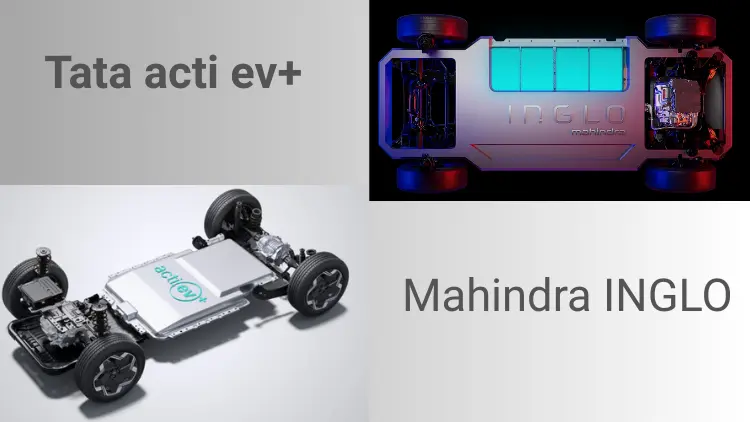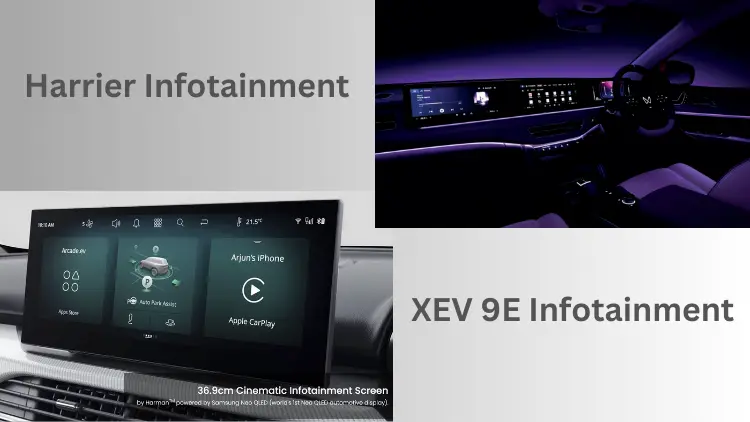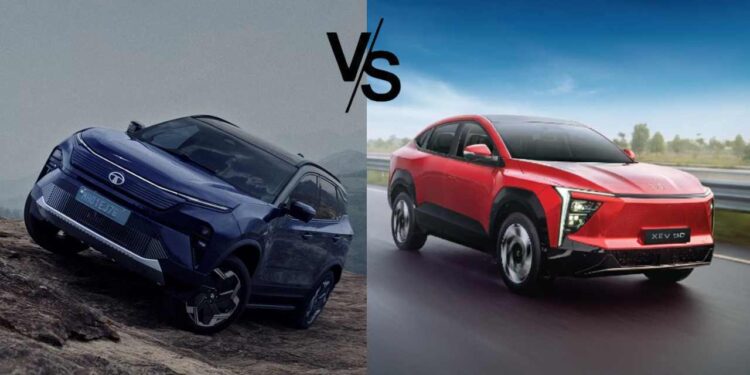Introduction
ITata Harrier EV vs Mahindra XEV 9e : India’s EV market is evolving fast, and 2025 is proving to be a landmark year. With increasing adoption, better charging infrastructure, and strong government policy support, electric vehicles are no longer niche — they’re becoming mainstream choices across segments.
Two of the most important launches in the premium EV SUV category are the Tata Harrier EV and the Mahindra XEV 9e. Both models represent the best of homegrown engineering, combining long range, high safety standards, and future-ready technology. Tata brings its successful Harrier nameplate into the electric era, while Mahindra expands its Born Electric range with the XEV 9e. On paper, both SUVs promise comfort, technology, and efficiency. Let’s compare them in detail.
Design & Road Presence
Tata Harrier EV
The Harrier EV blends its strong SUV proportions with a forward-looking EV identity. The signature connected LED DRLs and tail-lamps highlight its modern styling, while the closed grille and sharp character lines improve aerodynamics. The SUV retains its muscular stance but adds subtle EV cues to differentiate it from the ICE Harrier.
Inside, the Harrier EV delivers a premium and tech-forward experience. A 12.3-inch infotainment screen sits at the center, paired with a 10.25-inch digital cluster. Premium upholstery, ambient lighting, and a well-laid-out cabin emphasize comfort and sophistication. Practicality has also been enhanced with the inclusion of a frunk (front trunk), adding extra storage to the already spacious SUV.
Mahindra XEV 9e
The Mahindra XEV 9e presents a bold and futuristic design language. With its coupe-inspired silhouette, wider stance, and striking signature LED light bars, it projects a road presence that feels modern and international. Its dynamic proportions and flush design elements set it apart from conventional SUVs.
The cabin is a showcase of Mahindra’s technology-first approach. The large multi-screen layout, anchored by a 12.3-inch infotainment display and an Augmented Reality HUD, creates an immersive driving environment. Audio is powered by Harman’s 3D surround system, giving a strong edge in entertainment. Mahindra also introduces Boss Mode for rear passengers, maximizing legroom, while a front frunk adds valuable practicality for everyday use.
Takeaway: The Harrier EV leans on muscular SUV DNA with subtle EV cues, while the XEV 9e emphasizes futuristic design with coupe-like flair.
Powertrain & Performance

Tata Harrier EV
Tata offers both RWD and AWD configurations, giving customers a choice between efficiency and all-weather capability. The dual-motor AWD delivers up to 394 PS and 504 Nm, ensuring quick response and strong traction. Multiple drive modes and regenerative braking levels allow drivers to adapt the SUV’s behavior to city commutes, highways, or even rough terrain. This flexibility makes the Harrier EV a versatile option for performance-focused buyers as well as families.
Mahindra XEV 9e
Mahindra keeps things simpler with a single-motor RWD setup across all trims. Power output peaks at 285 PS with torque around 380 Nm, tuned for smooth, efficient delivery. While it lacks an AWD option, the XEV 9e benefits from a wider stance and longer wheelbase, which enhances stability during highway cruising. Multiple drive modes and regen settings give drivers control over efficiency and driving feel, ensuring predictable and comfortable performance.
| Specification | Tata Harrier EV | Mahindra XEV 9e |
|---|---|---|
| Motor Options | Single-motor (RWD) and Dual-motor (AWD) | Single-motor (RWD only) |
| Max Power | Up to 394 PS (AWD variants) | Up to 285 PS |
| Max Torque | 504 Nm (AWD variants) | ~380 Nm |
| Drivetrain | RWD for entry variants; AWD for higher trims | RWD only across the range |
| Drive Modes | Multiple drive + terrain modes; adjustable regen | Multiple drive modes; adjustable regen |
| Performance Features | Dual-motor AWD, selectable terrain modes, strong SUV stability | Smooth single-motor setup, optimized for efficiency, wide stance adds stability |
Key Takeaway: The Harrier EV offers buyers the flexibility of RWD and AWD, with higher outputs in dual-motor trims. The XEV 9e sticks to RWD only, focusing on simplicity and efficiency.
Battery & Range
The Tata Harrier EV offers flexibility with two battery sizes — 65 kWh for those who want affordability and 75 kWh for those who crave maximum range. Depending on configuration, the SUV delivers between 538 km and 627 km certified range, which translates to around 420–505 km in real-world usage. Its charging system supports 7.2 kW AC home charging, with full top-ups in 9–10 hours, while 120 kW DC fast charging slashes the 20–80% charge window to just 25 minutes. Tata also equips the Harrier EV with bi-directional charging tech (V2V and V2L), letting owners power external devices or even charge another EV — a feature that boosts practicality during road trips or emergencies.
The Mahindra XEV 9e pushes the bar with slightly bigger packs — 59 kWh and 79 kWh — and a segment-leading 656 km claimed range on the larger option. Even in real-world urban conditions, Mahindra suggests 500+ km on the 79 kWh pack, making it ideal for long commutes and highway trips. Where it really shines is in charging speed: the 180 kW DC fast charge input allows a 20–80% top-up in just 20 minutes, the fastest in its class. AC charging flexibility is also better here, thanks to an optional 11.2 kW onboard charger. Add in the massive 150-litre frunk upfront, and the XEV 9e clearly emphasizes long-distance practicality and day-to-day usability.
| Specification | Tata Harrier EV | Mahindra XEV 9e |
|---|---|---|
| Battery Options | 65 kWh, 75 kWh | 59 kWh, 79 kWh |
| Certified Range | 538–627 km (depending on variant) | 542–656 km (depending on variant) |
| Real-World Range | ~420–505 km | 500+ km (79 kWh pack) |
| DC Fast Charging | Up to 120 kW (20–80% in ~25 min) | Up to 180 kW (20–80% in ~20 min) |
| AC Charging | 7.2 kW (9–10 hrs full charge) | 7.2 kW or 11.2 kW (6–11.7 hrs full charge) |
| Bi-Directional | V2V (5 kVA), V2L (3.3 kVA) | Not available |
| Frunk Space | 35–67 litres | 150 litres |
Key Takeaway: The XEV 9e edges ahead with slightly higher range and faster charging, while the Harrier EV counters with versatile battery packs and bi-directional charging.
Driving Dynamics
Tata Harrier EV
The Harrier EV has been engineered to feel secure and versatile. Buyers get RWD for everyday efficiency or AWD in higher trims, which brings added confidence when roads get tricky. Tata equips the SUV with multiple terrain modes — Wet, Rough, and Normal — paired with adjustable regenerative braking levels via steering-mounted paddles.
On the road, the Harrier EV feels planted thanks to its wide track and SUV stance. The AWD system continuously distributes torque between front and rear axles, offering reassurance on rain-soaked highways or rural patches. Its suspension soaks up potholes and uneven surfaces, delivering comfort while keeping body roll under control. The quiet EV powertrain, combined with a stable ride, makes long highway journeys less tiring.
Mahindra XEV 9e
The XEV 9e is offered only with RWD, focusing on predictable handling and smooth power delivery. Its wider stance and longer wheelbase enhance stability at speed, making it particularly comfortable for expressway cruising.
In the city, the linear power delivery feels intuitive and easy to manage. On highways, it remains composed and steady, while the low-slung battery pack keeps the center of gravity in check. The suspension is tuned for compliance, absorbing rough patches and speed breakers without unsettling passengers. This makes the XEV 9e a dependable long-distance cruiser that’s equally at ease in urban traffic.
Technology & Infotainment

| Feature | Tata Harrier EV | Mahindra XEV 9e |
|---|---|---|
| Infotainment | 12.3-inch floating touchscreen with Arcade.ev apps, OTA updates | 12.3-inch central display with advanced UI, split-screen |
| Driver Display | 10.25-inch full digital cluster | Fully digital instrument panel |
| Head-Up Display | Not available | Augmented Reality HUD |
| Digital Mirror | Digital IRVM | Not available |
| Audio | JBL 10-speaker Dolby Atmos system | Harman 3D surround audio |
| Connectivity | Wireless Android Auto & Apple CarPlay, connected suite | Wireless Android Auto & Apple CarPlay, app-based connected suite |
| OTA Updates | Yes | Yes |
| Extras | Arcade.ev entertainment, wireless charging | Multi-screen cockpit, remote app features |
Takeaway: The Harrier EV offers a more traditional premium tech package, while the XEV 9e goes all-in on futuristic features like the AR HUD and lounge-like rear comfort.
ADAS & Safety
Safety is one of the strongest suits for both these premium EV SUVs.
The Tata Harrier EV offers a well-rounded Level 2+ ADAS package, covering features like Adaptive Cruise Control, Lane Keep Assist, Autonomous Emergency Braking, and Traffic Sign Recognition. It also adds rear cross-traffic alert and blind-spot monitoring. On the dynamics side, the Harrier EV includes ESP, hill hold, hill descent control, and roll-over mitigation. Parking is made stress-free with a 360-degree camera offering multiple angles, supported by blind-spot view monitoring. Combined with its Bharat NCAP 5-Star rating for both adult and child protection, the Harrier EV stands out as a family-friendly choice.
The Mahindra XEV 9e is equally confident in its safety package. It also delivers a Level 2+ ADAS suite with adaptive cruise, lane-keeping aids, AEB, and blind-spot detection. Mahindra adds thoughtful extras such as Driver Drowsiness Alert and Auto High Beam Assist. Its wide footprint is easier to manage thanks to a 360° surround camera and front-rear parking sensors. Standard essentials like ESP, TPMS, ISOFIX mounts, and an emergency call system further boost security. With its own 5-Star Bharat NCAP rating, the XEV 9e gives buyers complete confidence.
| Specification | Tata Harrier EV | Mahindra XEV 9e |
|---|---|---|
| Airbags | 7 airbags (front, side, curtain, driver knee) | 7 airbags (front, side, curtain, driver knee) |
| ADAS Features | Level 2+ (Adaptive Cruise, Lane Keep, AEB, TSR, Blind Spot, RCTA) | Level 2+ (Adaptive Cruise, Lane Keep, AEB, TSR, Blind Spot, Drowsiness Alert) |
| Parking Assistance | 360° camera with multiple views, blind-spot monitor | 360° surround view, front & rear sensors |
| Driver Aids | ESP, Hill Hold, Hill Descent, Roll-over Mitigation | ESP, Hill Hold, Auto High Beam Assist |
| Crash Rating | Bharat NCAP 5-Star | Bharat NCAP 5-Star |
| Other Features | ISOFIX, TPMS, electronic parking brake with auto-hold | ISOFIX, TPMS, Emergency Call (e-Call), Speed Assist |
Comfort & Practicality
Comfort & Practicality
Both the Tata Harrier EV and Mahindra XEV 9e focus strongly on making everyday ownership comfortable and family-friendly, but they approach it in slightly different ways.
In the Harrier EV, front occupants are treated to ventilated seats, with the driver’s seat getting power adjustment and memory function, while the co-driver benefits from height adjustment. The rear passengers enjoy wide seats, dedicated AC vents, a central armrest, and even Boss Mode, which slides the front passenger seat forward to free up extra legroom. The dual-tone soft-touch dashboard, premium upholstery, and 64-colour ambient lighting create an upscale cabin ambience. Practicality is enhanced with thoughtful touches like a cooled storage console, multiple USB-C ports, wireless charging, a gesture-powered tailgate, and a digital IRVM. The frunk adds between 35–67 litres of extra storage, making it easier to manage luggage and small items on trips.
The XEV 9e, meanwhile, emphasizes futuristic convenience. Both front seats are ventilated and powered, with memory and lumbar support, while the driver’s seat also features a welcome retract function for easier ingress and egress. Rear passengers get the luxury of Boss Mode, reclining seats, a panoramic sunroof, and rear sunshades — making the back row lounge-like for long journeys. The wide-body cabin, with customizable ambient lighting, feels spacious and premium. Storage is a strong point, too, thanks to its segment-leading 150-litre frunk, a generous boot, wireless charging, and multiple USB-C ports. Added conveniences like an app-powered tailgate and remote climate control underline its tech-forward approach, while family-friendly touches such as ISOFIX mounts, a flat rear floor, and thoughtful rear-seat features make it a practical choice for everyday use.
| Category | Tata Harrier EV | Mahindra XEV 9e |
|---|---|---|
| Front Seats | Ventilated seats, powered driver seat with memory, height-adjustable co-driver | Ventilated, powered seats with memory & lumbar support, Driver seat with memory and welcome retract |
| Rear Comfort | Boss Mode, wide seats, AC vents, center armrest | Boss Mode, panoramic sunroof, recline, sunshades |
| Cabin Ambience | Dual-tone soft-touch dash, premium upholstery, 64-colour ambient lighting | Wide-body cabin, customizable ambient lighting |
| Storage | Cooled console, USB-C ports, wireless charging, frunk (35–67 L) | 150 L frunk, boot storage, USB-C ports, wireless charging |
| Convenience | Gesture-powered tailgate, digital IRVM | App-powered tailgate, remote climate control |
| Family Features | ISOFIX, flat rear floor, split-folding rear seats | ISOFIX, reclinable seats, rear sunshades |
Motors77 Verdict
The arrival of the Tata Harrier EV and the Mahindra XEV 9e marks a turning point for India’s electric SUV market. Both models prove that homegrown manufacturers can deliver global-standard EVs with impressive range, advanced safety, and high levels of comfort and technology.
The Tata Harrier EV is the more versatile of the two, thanks to its choice of RWD and AWD powertrains. Buyers who value confidence on varied terrain or highway stability will appreciate the dual-motor AWD system. The Harrier EV also stands out with its Arcade.ev infotainment suite, digital IRVM, and JBL Dolby Atmos audio system, which together create a premium, tech-rich cabin. Add in gesture-controlled powered tailgate, ventilated seats with memory function, and 64-colour ambient lighting, and you get an SUV that balances practicality with sophistication.
The Mahindra XEV 9e plays its strengths differently. With a larger 79 kWh battery pack and a class-leading 656 km range, it is the clear choice for those who travel long distances. Its 180 kW DC fast charging capability makes it future-ready. Inside, the XEV 9e pushes futuristic boundaries with its AR HUD, Harman 3D surround audio, and Boss Mode rear lounge. Add the massive 150-litre frunk, panoramic sunroof, and app-based conveniences, and it becomes the practical, tech-forward choice for families.
In the end, your choice will depend on priorities:
- Pick the Harrier EV if you want SUV adventure, stability, and tech that supports both off-road ruggedness and city polish.
- Pick the XEV 9e if your focus is range, fewer charging stops, a plush cabin, and futuristic comfort features that enhance the experience of owning an EV in 2025.
Both SUVs are winners in their own right. The Harrier EV appeals to buyers seeking a balance of performance, luxury, and everyday usability, while the XEV 9e is tailor-made for long-distance commuters and families who want space, efficiency, and cutting-edge technology. Together, they represent the best of India’s EV engineering and set new benchmarks for the segment.
Note: Both the Harrier EV and XEV 9e come loaded with extensive feature lists across trims. This review highlights the most significant aspects, but not every single feature could be detailed here. Buyers are encouraged to check official brochures or dealer information for the full list.










